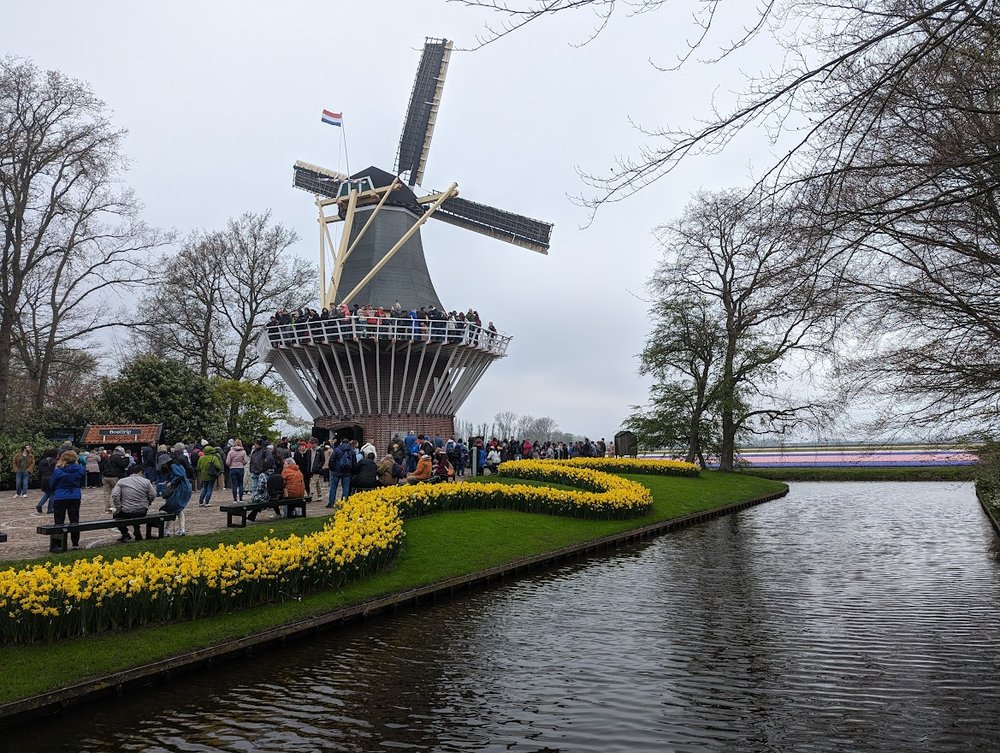Belgium in April: Get Me to the Nunnery

Keukenhof Garden in Lisse, Netherlands is only open to the public for an 8-week tulip display from mid-March to mid-May (Photo by Cecilia Manguerra-Brainard).
Belgium nudged memories of the Belgian nuns who had taught me at St. Theresa’s College (STC) in Cebu and in Manila for a total of 13 years. STC had been founded by the Belgian Mother Marie Louise De Meester.
Because of this connection, Belgium became more interesting. For starters, it fascinated me that Belgium, the Netherlands and Luxembourg are referred to as “low countries.” It was while sailing through the canals and locks when I fully understood that they were called such because they were below sea-level. The peoples of these countries hold back the sea via locks, dikes and pumps.
The second thing I observed was how wealthy Belgium is. It ranks 18th on the list of the world’s richest countries. Billions of dollars are exchanged in Antwerp, the diamond capital of the world. The Antwerp harbor is the second largest in Europe. Brussels is the capital of the European Union. And yet Belgium seems relatively low-key compared with other European countries.
Its towns and cities display a sense of order, neatness and discipline. Even the red-light district in Antwerp is orderly. Prostitution is legal in Belgium (as it is in the Netherlands), and the district is patrolled by police for safety. There is a medical clinic nearby for medical or psychiatric emergencies. While Belgium has legalized prostitution, it has deep-seated Catholicism. In Antwerp, we saw paintings by the famous Peter Paul Rubens in the cathedral. Ghent cathedral’s altarpiece was created by Jan van Eyck. The church of Our Lady in Bruge has a marble sculpture by Michelangelo of the Virgin and Child.

Old section of Ghent, Belgium (Photo by Cecilia Manguerra-Brainard)
This contradiction made me consider my Belgian nuns. I wondered just how much of their values were injected into me. They were strict but excellent educators. I remember their long white robes and elaborate head covering that reminded me of Batman’s head gear. Eventually, the sisters modernized their clothing and favored blouses and skirts. Somehow, I just had to search for traces of my Belgian nuns in Belgium, not literally, but to find some evidence of them there.
Our stop in Ypres, Belgium gave me the opportunity because Mother Marie Louise De Meester (foundress of STC) became a nun at Ypres. Born in Roesalare in 1857, which is near Ypres, she joined the Canoness Regular of Ypres at the medieval Abbey of Notre Dame de las Nouvelle Plante.

The O.L. Vrouw ter Nieuwe Plant School I found in Ypres, Belgium (Photo by Cecilia Manguerra-Brainard)
At some point, she founded the Missionary Sisters of the Immaculate Heart of Mary (ICM). Mother Marie Louise started her missionary work in India in 1897 where she established an orphanage. Her work spread to the Philippines, China, the United States and the Belgian Congo. Today, the ICM sisters serve in Belgium, Brazil, Burundi, Cameron, The Caribbean, Congo, Guatemala, Hong Kong, India, Italy, Philippines, South Africa, Taiwan and the United States.
Ypres is a small, ancient walled city with a long and rich history, from the Romans to World Wars I and II. Our cruise group, dominated by British vacationers, went to Ypres to visit the World War I Memorial where more than 250,000 allies died from German artillery and attacks. (Two hundred thousand German soldiers lost their lives.) Our companions also visited the Flanders Fields Museum, which is dedicated to the study of the First World War. My mission was to locate Mother Marie Louise’s Abbey of Notre Dame and maybe find some evidence of her presence there.
I went to the first big church I saw, but it was not the Abbey. I asked our tour guide where the Abbey of Notre Dame was, and he sent me to St. Martin’s Cathedral. Finally, I went to the tourist office and asked a woman who appeared puzzled when I mentioned the Abbey. I showed her a write-up on Mother Marie Louise and the Abbey. She read it, then her face lit up – “This was in 1881,” she said. “The Abbey is no more.”
I had forgotten that since Mother Marie Louise’s time, two World Wars had hit Ypres, perhaps destroying the Abbey at some point.
“But there is a school… but you may not find nuns. It is Easter holiday,” she offered.
The school wasn’t far, and it was closed, but I walked around and took pictures. It looked like an elementary school with a playground in the back. The front building had a sign: “O.L. Vrouw ter Nieuwe Plant.”
Back on the ship, I did some research about the Abbey of Onze-Lieve-Vrouw ter Nieuwe Plant . The information matched the history of Mother Marie Louise. The Abbey was a community
of Augustinian canonesses dating from the 1239 in Roesbrugge. Because of wars, the Abbey moved to Ypres. When World War I broke out, the nuns left Ypres and took refuge in England. They went to France in 1915, and in 1919 returned to Ypres. In 1921, they rebuilt and the Abbey. The building I saw in Ypres was the school, no longer called Notre Dame but “O.L. Vrouw ter Nieuwe Plant.”
I came across another interesting thing in the next Belgian city we visited, Bruges. Above a doorway was a sculpture of a Beguine (lay religious woman). The image showed a woman clothed in medieval dress with a headdress that looked like the batman headdress of my Belgian teachers. Also related to my quest, in Bruges, I saw a shop with the name “de Meester” – the family name of Mother Marie Louise.

This is a sculpture of a medieval beguine (lay religious) above a doorway, in Bruges, Belgium. The dress is similar to what the nuns at STC wore. (Photo by Cecilia Manguerra-Brainard)

Building in Bruge, Belgium, with "De Meester" sign. The founder of the Missionary Sisters of the Immaculate Heart of Mary was Marie Louise De Meester. (Photo by Cecilia Manguerra-Brainard)
These were the bits of information I discovered relating to my Belgian teachers. I am not sure my conclusions are accurate, but it was fun trying to find their roots in Belgium.

Cecilia and her husband took a Riviera River Cruise on board the Oscar Wilde - “Bruges, Medieval Flanders, Amsterdam & the Dutch Bulb Fields.” Cecilia Manguerra Brainard is the author and editor of over 20 books, including her Selected Short Stories, which was just awarded the 40th National Book Award for Best Book Short Fiction in English. She also just released a book she edited, Growing Up Filipino 3: New Stories for Young Adults. Her official website is ceciliabrainard.com.
More articles from Cecilia Manguerra Brainard






No comments:
Post a Comment